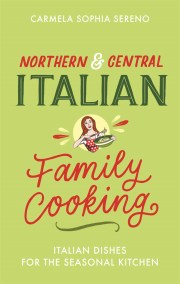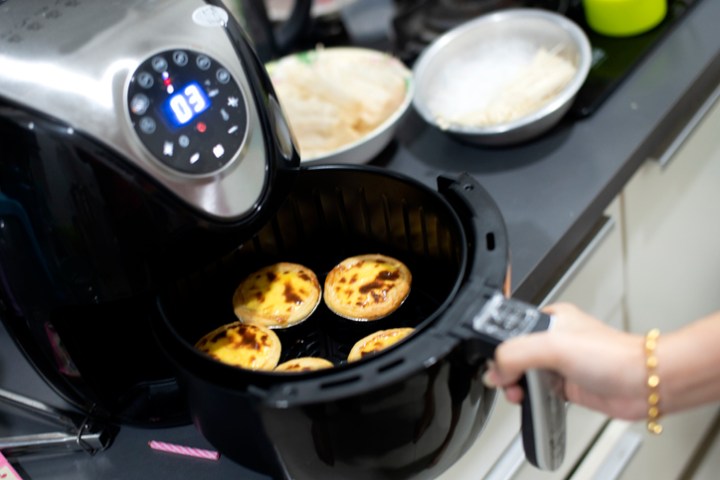How to put on a feast fit for summer

Planning a summer party but don’t fancy yet another barbecue? Whether you’re having friends and family over or simply want to put on an extra special spread for the weekend, these delicious recipes will help you cook up a feast fit for summer with very little fuss. These recipes come from Carmela Sereno’s latest book, Northern & Central Italian Family Cooking, which takes readers on a seasonal journey through thirteen regions of Italy, from the dolomites as far south as Lazio and Abruzzo.
Summer . . .
Long, lazy summer days. Weekends off work with family and friends. The laughter of children and the aroma of outdoor cooking. A sizzling barbecue, the always-acceptable popping of a cork at midday, the overeating and, more importantly, the sharing of food and memory-making.
Summer brings with it strawberries that actually taste sweet, ooze juice and leave you eating an entire punnet without realising it, so it’s obligatory that I recommended you try without question my strawberry and prosecco risotto, finishing with a cheeky shot of prosecco poured over before serving.
Filled courgette flowers have to be one of the most popular and longingly anticipated edible flowers of the year, both in Italy and in the UK. They can be filled with ricotta and anchovy, dipped in batter and fried or filled with ricotta and lemon zest, battered and fried, then drizzled with a ridiculous amount of borage honey, and courgette fritters make the perfect light lunch, stuffed into a panino or eaten as a snack on the run.
The huge abundance of tomatoes at this time of year should be embraced. Use them and love them. I also sun-dry and preserve some for autumn, giving me a distant but delicious memory of summer flavours when the season has passed. Remember that tomatoes should be kept out of the fridge, in a bowl at room temperature. Straight from a fridge, even the most delicious of tomatoes will have no flavour. If you grow your own, please retain the tomatoes’ vines for future use – a fantastic frugal tip that add punches of flavour with no effort. Use the tomato vines in your sauces, stocks and soups as a herb, and when used, simply discard. You can freeze the vines and use them directly from the freezer when required.
Artichokes filled with Taleggio, Carciofi ripiene di Taleggio
Artichokes filled with fragrant basil, soft Taleggio and wrapped in a coat of salty speck. This is one of my favourite starters, not only because of its simplicity but also because using artichokes from a tin or jar means there’s limited preparation. It isn’t dependent on the seasons for the same reason. Perfect as a weekend snack or starter served with a wonderfully deep, aged balsamic vinegar. Dip me, fry me, eat me!
Serves: 6
Preparation time: 15 minutes
Cooking time: 20 minutes (as you will need to batch-cook them)
12 small artichoke hearts, from a jar or tin
12 large basil leaves
250g Taleggio, cut into 12 pieces
12 slices of speck or prosciutto
1 litre sunflower oil, for deep-frying
4 tbsp ‘00’ flour
rocket leaves, to serve
For the batter
1 large egg white, beaten
140ml sparkling water
100g ‘00’ flour
pinch of dried oregano
grated zest of 1 lemon (cut the zested lemon into wedges, to serve)
- Drain the artichokes and pat them dry with kitchen paper. Handling them with care, use a teaspoon make a small hole in the centre of each artichoke.
- Push a basil leaf into the base of each artichoke followed by a piece of soft Taleggio.
- Wrap each artichoke firmly in a piece of speck, secure with a cocktail stick and leave to one side.
- Heat the oil in a large high-sided saucepan to 190°C (375°F). If you don’t have a thermometer to hand then simply drop in a mall cube of bread – it should brown within 30 seconds.
- To make the light batter, whisk the egg white and sparkling water together in a bowl, then add the flour and whisk until smooth. Season with salt, pepper and stir in the dried oregano and lemon zest.
- Put the 4 tablespoons of flour in a shallow bowl. Coat 4 of the artichokes in the flour then dip them in the batter. Fry the artichokes for about 4 minutes until golden, remove with a slotted spoon and transfer to kitchen paper to absorb excess oil. Repeat this process with the remaining stuffed artichoke hearts.
- Serve the fried artichokes on a platter with rocket leaves and lemon wedges.
Filled and Deep-fried Courgette Flowers, Fiori di zucchini
I would sooner receive the gift of two or three courgette flowers than a dozen red roses. I look forward to getting my hands on them most of the year, from summer to summer. This season always reminds me of my dad Rocco’s allotment being overrun by courgettes that all hold their own unique bud. Early in the courgette season, the male courgette flowers appear on a stem that produces no flower. Later in the season, the female flower is produced bearing the courgette. On the inside, each flower is a little different, with the male flower housing a single stamen, while the more voluptuous flower from the female have a slightly more complex interior. Irrespective of sex, remove the centre buds and stamens of both flowers and prepare them for filling.
Serves: 4
Preparation time: 15 minutes
Cooking time: 15 minutes
You will need: a piping bag (optional)
For the filling
250g ricotta
1 egg yolk
4 anchovy fillets (in oil), finely chopped
grated zest and juice of 1 small lemon
leaves from 4 sprigs of marjoram and thyme
½ tsp dried oregano
1 litre sunflower or light olive oil, for deep-frying
8 courgette flowers, washed and internal buds removed
salt and freshly ground black pepper
For the batter
1 egg white
4 tbsp ‘00’ flour
1 tbsp lemon juice
30ml sparkling water, at room temperature
Prosecco Risotto with Strawberries, Risotto di prosecco e fregola
Take a simple plain, white risotto and pour in the freshness of prosecco bubbles from the town of Valdobbiadene, in the province of Treviso, Veneto, then pair it with the natural sweetness of ruby-red seasonal strawberries. This dish requires the sweetest of strawberries so please only make it during the British strawberry season, which is usually from mid-May to the end of September.
Serves: 4
Preparation time: 25 minutes
Cooking time: 30 minutes, plus resting time
350g strawberries, quartered
250ml prosecco
650ml vegetable stock
1 tbsp olive oil
60g salted butter
1 shallot, thinly sliced
1 garlic clove, crushed
350g vialone nano risotto rice
60g Parmigiano-Reggiano, grated
1 tbsp finely chopped mint leaves, plus extra to serve
salt and freshly ground black pepper
- Put almost all the quartered strawberries in a bowl with 50ml of the processo and leave them to steep for 15 minutes.
- Warm the stock in a saucepan, taste and check for seasoning, adjusting as necessary.
- Heat the oil and 30g of the butter in a shallow sauté pan over a medium heat, add the shallot and fry for about 5 minutes until translucent, then add the garlic and cook for 2 minutes, stirring well.
- Add the risotto rice to the pan and stir over a medium heat, coating the rice in the shallot mixture, and toast it for 1 minute, then add the prosecco and stir for 5 minutes or so, allowing the prosecco to evaporate.
- Slowly begin to add the stock, one ladle at a time, stirring frequently with a wooden spoon that has a hole in the centre (if you have one), and cook for about 18 minutes until the rice is cooked and al dente. Season to taste with salt and pepper.
- Strain the strawberries and reserve the prosecco for drinking.
- Remove the risotto from the heat and add the Parmigiano and the rest of the butter. Stir well, cover the pan with a clean tea towel and clamp on a lid. Leave the risotto to rest for 5–10 minutes.
- Add the chopped mint leaves and the Prosecco-steeped strawberries to the risotto and serve it on warmed plates with a scattering of fresh strawberries and tiny mint leaves.
CARMELA’S TIPS:
- Arborio or carnaroli rice are equally acceptable alternatives to vialone nano.
- As I serve each plate of risotto, I love to pour a shot of prosecco over the dish.
Speck, Walnuts and Honey, Fico al gorgonzola e miele
I can still smell the aroma of the plump, green summer figs that Nonna Carmela passed to me in her tiny hands. Almost 91 years old, Nonna Carmela would say, in Italian, ‘Have them, Carmelina. One for now and one for your journey home.’ She understood my love for fresh figs, picked off her huge tree that spilled into her recently departed neighbour’s garden. Nonna was always battling the thieving birds, so would wrap each fig in either a small plastic bag or in old stockings with the aim of protecting them, if only to save but a few. I am a fig purist when it comes to eating them when they are in season – they require nothing but a hungry Carmela. That said, I am only one woman, so even I require a little help in eating them. This recipe is a classic with a little twist, as I like to use speck instead of prosciutto.
Makes: 6 filled figs
Preparation time: 15 minutes
Cooking time: 25 minutes
6 plump, seasonal figs
200g gorgonzola
6–12 slices of speck
honey, for drizzling
30g salted butter
70g walnuts, chopped
- Preheat the oven to 170°C fan (375°F/gas 5) and line a baking tray with baking parchment.
- Slice into the top of each fig, making a cross, but do not cut down to the base. Squeeze each fruit gently to open up the cross.
- Crumble gorgonzola into each cross then wrap each fig with a slice or two of speck. Place the figs on the lined baking tray, drizzle over a tiny amount of honey and bake in the oven for 25 minutes.
- Meanwhile, melt the butter in a small frying pan over a medium heat, add the walnuts and fry for 5 minutes. Remove the pan from the heat and add a teaspoon of honey and stir.
- Serve the figs in their crispy speck jackets on a slightly warmed platter. Sprinkle over the burnished walnuts and drizzle over a little more honey.
CARMELA’S TIP:
- Choose a seasonal or local honey. I currently have a love and fondness for borage honey.
-
Join Carmela Sereno on a culinary journey from the breath-taking dolomites as far south as Lazio and Abruzzo, taking in the delicious and decadent flavour of northern and central Italy.
What sets the northern and central regions of Italy apart from the cucina povera style of the south is its staple ingredients. From polenta, rice, pasta, game and seafood, to the use of butter, cream and alpine cheeses, the northern and central regions are much richer in terms of the ingredients they use. The result is an outstanding final flavour.
Carmela's passion for Italian food and drink culture is at the forefront of every recipe she creates. The recipes in her latest book include:
· Tomino cheese wrapped with basil and slices of speck
· Veal Milanese, classic osso bucco served with a delicate, saffron-infused risotto
· Cappellacci stuffed with rabbit, pork and veal
· Fontina fondue
· Roman oxtail stew
Whether an indulgent Friday night dinner or a quick weekday meal, the recipes in this book will please the whole family.








